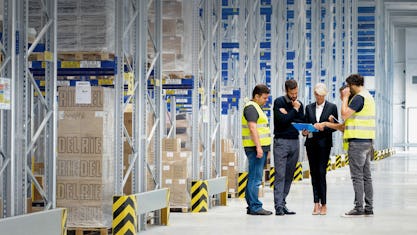Returns management as the basis for business success
Returns can significantly reduce a company's profits. Therefore, it is important to avoid returns or to optimize them in terms of customer loyalty.

Returns belong to the mail order business, as do shelves and containers to the warehouse or intralogistics. Especially in the age of e-commerce, the number of returned articles is increasing enormously. Some of them even belong to the business model. A rule of thumb states that "the closer the product is worn to the body, the higher the return rate". The clothing industry has a return rate of up to 50 percent and higher. Customers often order items for viewing and then send them back again. The companies make it easy for the customers and enclose the return slip. According to a popular online retailer for fashion, shoes and beauty articles, the return rate is 50 percent. According to the e-commerce magazine Bitkom, return shipments are used extensively, especially by younger online buyers. 14- to 29-year-olds return 18 percent of their ordered goods. Women make more use of the return option than men. In total, the number of returned parcels shipped annually is likely to amount to several hundred million. According to estimates, 3.5 billion consignments were transported by courier, express and parcel services in Germany in 2018. Not only is this a huge environmental problem, it also leads to extreme additional costs for dealers. According to EHI Retail Institute, the average cost of each returned item is around ten euros; for a few retailers, the average return cost is more than 50 euros per item. "In order to avoid returns in the long term, the majority of retailers (80 percent) are planning even more detailed product information in the online shop as the most important measure according to the EHI study," reports EHI Retail.
Better avoid returns
Even if returns are an instrument for increasing customer satisfaction, loyalty and sales, companies should prepare themselves logistically for returns and reduce the returns rate as much as possible. Sophisticated distribution systems optimize order and returns logistics enormously and increase the competitiveness of the online retailer. They meet the current requirements for flexibility, speed and maximum accuracy in eCommerce. Nevertheless, even with high logistical efficiency and optimisation, orders returned cannot be completely avoided. The processing of the remaining returns has to be optimized with regard to customer orientation as well as cost reduction. This is where returns management comes into play, as it includes all measures to minimize returns as well as efficient returns processing.
Key figures
Alpha, beta and gamma return rates
Companies record the quota of returned orders differently, namely with the alpha, beta and gamma return quota. With the alpha return rate, the sum of returned parcels is divided by the sum of sent parcels and multiplied by 100 percent. The alpha quota reflects the logistical perspective of returns management and enables better planning of physical processing. With the beta quota, the sum of returned items is divided by the sum of sent items and multiplied by 100 percent. The beta ratio reflects the marketing perspective and can provide valuable information for preventive avoidance and prevention, especially at the item level. For example, it may be necessary to delete articles from the programme or replace them with better ones. With the gamma quota, the sum of the values of the returned goods is divided by the sum of the values of the sent goods and multiplied by 100 percent. The gamma quotient is a value-oriented indicator that relates the value of the returned goods to the value of the outgoing goods.
loss of returns
The loss of returns can also be calculated. For e-commerce companies, returns mean additional expense and lost revenue. Together this results in the loss of returns. Influencing factors are the handling costs (logistics and administration), the shipping costs (if the customer does not bear these), the return damage (the customer cannot be invoiced) and the lost profit.
Optimum returns quantity
If a company allows returns, the loss of customers can be avoided - in other words, customers can be retained. The determination of the optimal return quantity compares the advantage of the return with the costs incurred. The advantage can also be seen as the avoidance of opportunity costs resulting from a loss of customers due to restrictive returns. A new cost curve is obtained from the sum of return costs and opportunity costs of the return restriction. This describes the total costs for a specific quantity of returns. You can therefore determine the returns quantity from which the lowest total costs arise (optimum returns quantity).
Returns handling and processing
Reverse logistics that runs counter to the company's purpose is a challenge for any organisation. Usually, the receipt of returned goods is included in the goods receipt. Returns processing comprises the following steps: Goods receipt, goods preparation, goods assessment (documentation), packaging, re-storage. The returns must of course be assessed, documented and then treated accordingly, e.g. washed or even disposed of. The documentation (customer data, reason for return, etc.) must be stored in the corresponding warehouse management or ERP system - also with regard to the key figures to be determined. In extreme cases, goods that are still at the customer's (before the return) are partly already offered for sale again. If the articles are judged as new, they are automatically repacked in most cases.
How to avoid returns?
First of all, it must be borne in mind that the rate of returns varies greatly from industry to industry. In the fashion sector it is often 50 percent or more, although in the pharmaceuticals sector it is only single-digit. Depending on the amount, it can strongly affect the profit. The reasons given for the return shipment are often "article does not fit", "does not like", "several articles ordered for selection" as well as "article deviating from description" and "article damaged". The quota can be reduced in many ways and preventive returns management can be carried out. The reduction in the number of returns starts long before the product is sold. A product must be selected that meets all quality requirements. Not only should a sample be ordered, but the current production should also be subjected to a quality inspection. The product description in the online shop should be very meaningful and be supported by good product pictures (e.g. 360-degree pictures) and high-quality videos. Good size tables must be available in the clothing sector. A personal chat or a hotline and a FAQ page answer customer questions and have a positive effect on the conversion rate as well as on the number of returns. Product evaluations also influence the perception of the customer (by other customers) of the quality of the product and thus also the return rate. In general, a very prompt processing of the order and the dispatch of the product leads to a reduction of the quota. If customers place an order in a shop that has a choice of "prepayment", "direct debit" or "immediate transfer" as payment methods, the return rate is significantly lower. The customer considers in advance whether he really wants and needs this article and whether he wants to spend so much money in advance. Another major influence is the protection against damage by the type of packaging and the selection of a reliable courier service. In addition, the customer should be able to track his shipment and, if necessary, ask the shop operator questions. Punctual deliveries can significantly reduce the number of returns. The return process should be constantly optimised by taking into account the key figures explained and the product questionnaires enclosed with the consignment. An elementary factor in returns management is the logistics of a company. The selection of the appropriate shelving system, container transport, picking methods as well as the complete internal processes determine the efficiency of the mail order business and at the same time the number of returns. More eCommerce industry information can also be found in the Solutions for Industries section.


